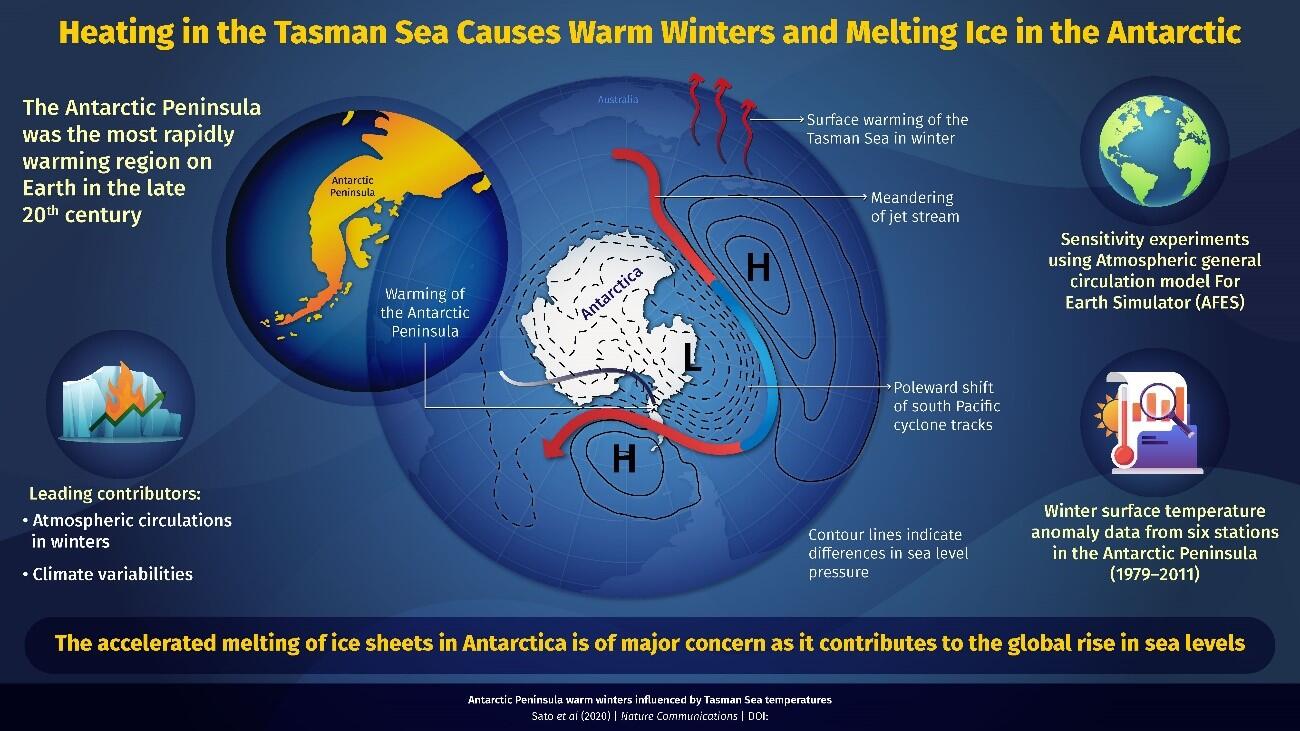An international research team made up of Assistant Professor Kazutoshi Sato, Kitami Institute of Technology, Associate Professor Jun Inoue, National Institute of Polar Research, and Professor Ian Simmonds and researcher Irina Rudeva, the University of Melbourne, Australia, examined the influence of interannual variability surface temperatures in the Tasman Sea, a mid-latitude body of water off the southeast coast of Australia, on rising temperatures on the Antarctic Peninsula. They found that low-pressure systems that would typically pass east of New Zealand were reaching into the Antarctic zone in years of high water temperatures in the Tasman Sea. This creates the atmospheric conditions for higher temperatures over the Antarctic Peninsula.

(Credit: Kazutoshi Sato (Kitami Institute of Technology))
The Antarctic Peninsula is one of the regions of the world that has experienced the greatest rise in air temperatures compared to the global average. It has been asserted that this is due to tropical factors such as El Niño and Antarctic oscillations from the polar zone. However, the impact of mid-latitude oceans had been overlooked. This study investigated the impact of the mid-latitude Tasman Sea, which has reported rising sea surface temperatures in recent years. Previous studies by the research team found that unusually high temperatures on the Antarctic Peninsula were caused by a strong influx of warm air from the tropics due to increased cyclonic activity over the Amundsen Sea off Antarctica.
Using surface air temperature data from six weather observation stations on the Antarctic Peninsula (from June to August), they conducted a composite analysis of 13 winters that were warmer than average ("warm" winters) and 12 winters that were colder than average ("cold" winters). During warm winters, low pressure prevailed over the Amundsen Sea (a cyclonic anomaly), while the area north of the Antarctic Peninsula saw dramatic prevailing high pressure (anticyclonic anomaly). This atmospheric pressure pattern facilitates the influx of warm air via northerly winds from the mid-latitudes to the Antarctic Peninsula. This brought warmer-than-average winters to the part of the Antarctic continent that includes the Antarctic Peninsula where the warm winds blew. This is consistent with previous studies.
On the other hand, focusing on the New Zealand region which includes the Tasman Sea, the seas east of New Zealand saw fewer low pressure systems in warm winters than usual. A composite analysis of surface water temperature also found that the Tasman Sea, located to the windward side of New Zealand, was warmer in warm winters than in other years. This showed that a warmer Tasman Sea pushed the track of low-pressure systems passing east across New Zealand some 1000km further south. This increases the number of low-pressure systems entering the Amundsen Sea region, which in turn indicates higher temperatures on the Antarctic Peninsula.
However, prior research found that the La Niña effect that reduces water temperatures in the tropics has a role in strengthening the low pressure anomalies over the Amundsen Sea. As such, in order to compare the role of the influence of the tropics and that of a warm Tasman Sea, a quantitative experiment was conducted using an Atmospheric General Circulation Model extracting the effect of marine heatwaves in the Tasman Sea only. This confirmed that stronger low-pressure systems over the Amundsen Sea and stronger anticyclones over the Antarctic Peninsula did bring warmer temperatures to the Antarctic Peninsula.
Sato explains that, "The changing tracks of low-pressure systems as a result of marine heatwaves in the Tasman Sea affect the distribution of cloud cover on the ocean. Clouds affect the amount of solar radiation that reaches the ground or ocean surface. As such, changes in cloud distribution in turn change water temperature distribution around Antarctica, which might further affect the tracks of low-pressure systems. Therefore, we look forward to studying the impact of this on cloud distribution and the changes that might incur."
This article has been translated by JST with permission from The Science News Ltd.(https://sci-news.co.jp/). Unauthorized reproduction of the article and photographs is prohibited.




